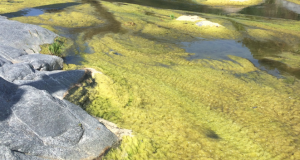Study investigates how to set site-specific eutrophication thresholds to protect health of California streams

SCCWRP and its partners have completed a study investigating the feasibility of developing site-specific targets to protect California’s wadeable streams from the ecological effects of eutrophication – an alternative to setting a single statewide set of eutrophication targets.
The methodology, described in a journal article published in March, is intended to provide the State Water Resources Control Board with multiple options as it works toward deciding how to set stream eutrophication thresholds via its forthcoming Biostimulatory Substances and Biological Integrity Provisions initiative.
During the study, researchers used “reach-specific modeling” to identify potential biological response thresholds for eutrophication for 46 sites in the Santa Margarita River watershed, then compared these site-specific thresholds to the statewide thresholds that California would need to set to offer a comparable degree of ecological protection.
Nearly all of the site-specific thresholds were higher than the statewide thresholds, meaning that achieving site-specific thresholds has the potential to be less costly than achieving statewide thresholds while still protecting biological integrity.
More news related to: Eutrophication, Harmful Algal Blooms